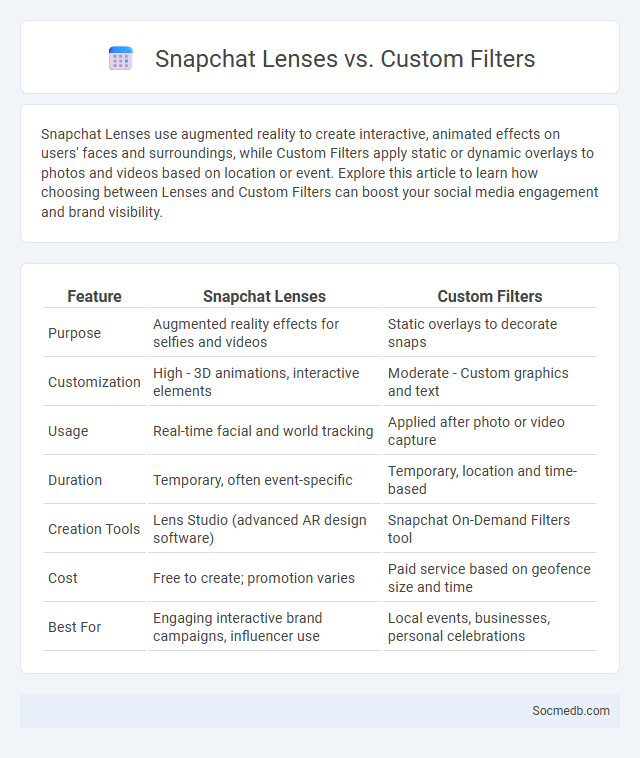
Photo illustration: Snapchat Lenses vs Custom Filters
Snapchat Lenses use augmented reality to create interactive, animated effects on users' faces and surroundings, while Custom Filters apply static or dynamic overlays to photos and videos based on location or event. Explore this article to learn how choosing between Lenses and Custom Filters can boost your social media engagement and brand visibility.
Table of Comparison
| Feature | Snapchat Lenses | Custom Filters |
|---|---|---|
| Purpose | Augmented reality effects for selfies and videos | Static overlays to decorate snaps |
| Customization | High - 3D animations, interactive elements | Moderate - Custom graphics and text |
| Usage | Real-time facial and world tracking | Applied after photo or video capture |
| Duration | Temporary, often event-specific | Temporary, location and time-based |
| Creation Tools | Lens Studio (advanced AR design software) | Snapchat On-Demand Filters tool |
| Cost | Free to create; promotion varies | Paid service based on geofence size and time |
| Best For | Engaging interactive brand campaigns, influencer use | Local events, businesses, personal celebrations |
Understanding Snapchat Lenses: Features and Uses
Snapchat Lenses utilize augmented reality technology to overlay dynamic filters and animations on users' faces, enhancing visual engagement during photo and video sharing. Key features include facial recognition, real-time effects, and interactive elements that respond to user movements or expressions. These lenses are widely used for entertainment, brand marketing, and social storytelling, making Snapchat a leading platform for immersive social media experiences.
What Are Custom Snapchat Filters?
Custom Snapchat filters are personalized graphic overlays that enhance your photos and videos, allowing you to add unique designs, logos, or text tailored to specific events or locations. These filters can be created for personal use or business promotions, making your snaps stand out and engage your audience more effectively. You can easily design and submit your own custom Snapchat filters through Snapchat's platform, targeting the exact dates and geographic areas relevant to your needs.
Key Differences Between Lenses and Filters
Lenses and filters serve distinct roles in social media content creation, with lenses typically referring to augmented reality effects that alter or enhance facial features and environments in real-time, popular on platforms like Snapchat and Instagram. Filters generally adjust overall color tones, contrast, brightness, or apply stylistic overlays to photos and videos, often used to create specific moods or aesthetics. The key difference lies in lenses providing dynamic, interactive experiences, while filters offer static visual modifications to enhance user-generated media.
Creating Your Own Snapchat Lens
Creating your own Snapchat Lens involves using Lens Studio, a powerful AR development platform provided by Snap Inc. By leveraging 3D modeling, animations, and interactive features, creators can design unique augmented reality experiences that engage users and enhance brand visibility. Optimizing your Lens with trending themes and targeted filters increases user interaction and shareability on social media platforms.
Designing Custom Snapchat Filters: A Step-by-Step Guide
Designing custom Snapchat filters involves selecting a theme, incorporating unique visuals, and ensuring compliance with Snapchat's creative guidelines to maximize engagement and brand visibility. Use design tools like Adobe Photoshop or Canva to create 1080 x 2340 pixels transparent PNG files, focusing on eye-catching graphics optimized for mobile viewing. Submit the filter through Snapchat's On-Demand service, specifying location and duration to target your desired audience effectively.
Comparing User Engagement: Lenses vs. Filters
User engagement on social media significantly differs between lenses and filters due to their interactive and visual effects. Lenses, often powered by augmented reality, encourage higher user interaction by altering facial features or surroundings in real-time, leading to increased sharing and prolonged use. Filters primarily change the overall color tone or style of images and videos, resulting in quicker, less immersive interactions but still driving substantial engagement through aesthetic enhancement.
Branding Opportunities: Custom Lenses vs. Custom Filters
Custom lenses on social media platforms allow brands to create immersive, interactive experiences that enhance user engagement and increase brand visibility through augmented reality effects tailored specifically to the brand's identity. Custom filters, while simpler, provide quick and widespread brand recognition by overlaying logos or thematic visuals on photos and videos, encouraging organic sharing among users. Combining both tools strategically amplifies branding opportunities by merging interactive user participation with broad audience reach.
Cost and Accessibility: Filters vs. Lenses
Filters on social media platforms typically offer a low-cost or free option to enhance your content, making them highly accessible to a broad audience without requiring additional purchases. Lenses, often more advanced and interactive, may come with higher development costs or premium pricing, limiting accessibility but providing richer user engagement. Your choice between filters and lenses depends on balancing budget constraints with the desired level of creative expression and audience interaction.
Choosing the Right Option for Your Snapchat Campaign
Selecting the right option for your Snapchat campaign involves analyzing your target audience's demographics, interests, and behaviors to tailor content that drives engagement. Utilize Snapchat's array of ad formats, such as Snap Ads, Story Ads, and Collection Ads, to align with your marketing objectives, whether increasing brand awareness, traffic, or conversions. Leveraging audience insights and A/B testing ensures optimal ad performance and maximizes return on investment.
Future Trends in Augmented Reality: Snapchat’s Innovations
Snapchat is pioneering future trends in augmented reality by integrating advanced AI-driven filters and interactive 3D experiences that enhance user engagement. Their innovations include real-time AR shopping, virtual try-ons, and location-based effects that personalize content for Your social media interactions. These technologies are transforming how users communicate and interact with digital environments, setting new standards for immersive social media experiences.
 socmedb.com
socmedb.com